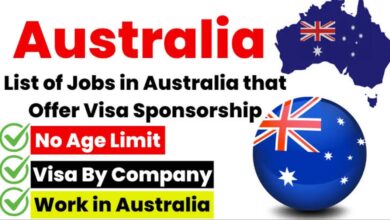How to Apply and Get Approval for an Australian Work Visa from Nigeria in 2025
Thinking of working in Australia? That’s a great idea. But getting an Australian work visa can be daunting. The truth is, it’s not as complicated as you might think. Once you understand the process, you’ll see just how straightforward it is. Many people miss out on opportunities because they don’t have the right information or make avoidable mistakes during the application process. You don’t have to be one of them. In this post, we’ll walk you through the application process step-by-step. That way, you can apply with confidence and increase your chances of getting approved. You’ll find that once you know the ropes, it’s not as hard as you thought it would be.
How Do Australian Work Visas Work?
Australian work visas might seem confusing at first, but they don’t have to be. Once you get into the details, the process becomes a lot clearer. You can work in Australia for a set period with a work visa, and when that expires, you either renew it or head back home. The Australian Department of Home Affairs is in charge of matching workers with visas that fit their skills and industry.
There are several types of Australian work visas, but you’ll most often come across the Temporary Skill Shortage (TSS) visa (subclass 482), the Skilled Independent visa (subclass 189), and the Employer Nomination Scheme visa (subclass 186). Nonetheless, if you have skills Australia needs, then you’re in a good position. To get a work visa, you’ll need to demonstrate your skills, pass health and character checks, and meet the English requirement. That’s where your employer or you, depending on the type of visa, come in. If everything goes according to plan, you can work and live in Australia for the duration of your visa and later have the chance to be a permanent resident.
Who Needs a Work Visa in Australia?
If you’re not an Australian citizen or a permanent resident, you’ll need a work permit to work legally in Australia. That’s why it’s essential for your employer to include a clear statement in your job offer letter that the position is dependent on the candidate’s ability to legally work in the country.
What are the Requirements for an Australian Work Visa?
So you can better understand the requirements, we have highlighted them based on the visa categories:
1. Employer Nomination Scheme (ENS) Visa (Direct Entry Stream)
You’ll need to demonstrate that you have the skills necessary for the job (skills assessment may be required), be on the list of eligible skilled occupations, and be nominated by an Australian employer. You’ll also need to meet health and character requirements, have at least three years of relevant work experience, and be under 45 years old (with some exemptions). A good understanding of English is a must, as is reading or having the Life in Australia booklet explained to you. You’ll also need to sign the Australian Values Statement to be eligible for this visa.
2. Regional Sponsored Migration Scheme (RSMS) Visa (Direct Entry Stream)
This visa is for jobs in regional Australia. You’ll need to be nominated for a job there, be under 45 years old, be on the list of eligible skilled occupations, and have at least three years of relevant work experience. You’ll also need to commit to staying with your employer in regional Australia for at least two years. The other requirements are similar to those for the ENS visa above.
3. Skilled Independent Visa
You can be nominated by an Australian state or territory agency or invited to apply through an Expression of Interest (EOI) for this visa. You’ll need to score at least 65 points in the points test, be under 45 years old, be on the list of eligible skilled occupations, and have the skills necessary for the job (skills assessment may be required). You’ll also need to meet health and character requirements, have at least competent English, and read or have the Life in Australia booklet explained to you.
4. Temporary Skill Shortage Visa
You’ll need to be nominated by an approved sponsor for an occupation on the skills list which no Australian can fill for this visa. You’ll also need to have at least two years of relevant work experience, skills necessary for the job (skills assessment may be required), adequate health insurance, and meet health and character requirements. You’ll need to have at least competent English, read or have the Life in Australia booklet explained to you, and sign the Australian Values Statement.
5. Skilled Regional (Provisional) Visa
You can be nominated by an Australian state or territory agency or sponsored by an eligible relative. You’ll need to be invited to apply through an Expression of Interest (EOI), be under 45 years old, have suitable skills assessment and score at least 65 points in the points test. You’ll also need to have at least competent English, be on the list of eligible skilled occupations, and meet health and character requirements.
For the extended stay pathway
If you previously held a Skilled Regional Sponsored visa (subclass 475, 487), a Skilled Independent Regional visa (subclass 495), or a Skilled Designated Area Sponsored Provisional visa (subclass 496), you can apply for an extended stay.
6. Temporary Work (Short Stay Specialist) Visa
You’ll need to have highly specialized skills, knowledge, or experience. Your work duration must be six months or less. You’ll also need to have enough funds to support yourself and meet health and character requirements for this visa.
7. Temporary Work (International Relations) Visa
You’ll need to provide a letter of support from a government agency or international organization (for the Government Agreement stream), a foreign government agency, ministry, or school (for the Foreign Government Agency stream), or the Australian Government Department of Foreign Affairs Trade (DFAT) (for the Domestic Worker stream). You’ll also need to have adequate funds to support yourself and meet health and character requirements for this visa.
8. Distinguished Talent Visa
You’ll be nominated and contribute to Australia’s economic, social, or cultural development. You’ll be internationally recognized with a record of achievement and able to establish yourself in Australia. You’ll need to have at least functional English, meet health and character requirements, and read or have the Life in Australia booklet explained to you.
What are the Documents Required for an Australian Work Visa?
As for the documents required for an Australian work visa, these can vary depending on the visa type. Here are some general documents you may need:
- A valid passport
- Completed visa application form
- Supporting documents for your skills assessment (if required)
- Proof of health insurance
- Police certificates (if required)
- Proof of sufficient funds to support yourself
- Documents showing your qualifications and experience
- Documents showing your language proficiency
- Documents showing your knowledge of the Life in Australia booklet
- Documents showing your commitment to Australian values
Can I Apply for an Australian Work Visa Online?
Applying for an Australian work visa seems complex, but once you understand the process, it’s pretty simple. Here’s a step by step guide:
1. Choose the right visa
Go to the Australian Government’s Department of Home Affairs website to look at the different work visas available. The type of visa you apply for will depend on your skills, job offer (if any), and how long you plan to stay. For example, the Temporary Skill Shortage (TSS) visa (subclass 482) requires employer sponsorship, the Skilled Independent visa (subclass 189) is points based and doesn’t require a job offer. Make sure you fully understand the requirements of each visa before you proceed.
2. Check the Skilled Occupation List
Before you apply, check if your job is on the Australian Skilled Occupation List (SOL). This list includes occupations in high demand in Australia which increases your chances of approval. If your occupation isn’t on the list you may need to look at other visa options. The list also affects the type of visa you can apply for and the points you’ll receive during the assessment process. Keeping track of changes to the SOL is important as it’s reviewed regularly by the Australian government.
3. Employer nomination (if applicable)
If you’re applying for a sponsored visa, your employer must be registered with the Australian Department of Home Affairs and have a Transaction Reference Number (TRN) or employer ID. The employer must prove they couldn’t find a suitable Australian citizen or permanent resident for the job which may involve advertising the role locally. Once this is verified, your employer will nominate you and provide a detailed job offer letter which includes your salary, role, work location and contract terms.
4. Submit an Expression of Interest (EOI)
For independent skilled visas, you’ll need to submit an Expression of Interest (EOI) through SkillSelect, the government’s online application system. Your EOI includes details like your age, education, work experience and English language skills. Your application is scored based on a points system and higher scores increase your chances of being invited to apply. You don’t need a job offer to submit an EOI but you must meet the minimum points requirement based on your selected visa category.
5. Get invited to apply
After you submit your EOI you will need to wait for an invitation from the Department of Home Affairs to apply. Invitations are issued based on your points score and the demand for your occupation. Once invited you have 60 days to lodge a complete application. If you miss this window you may need to submit a new EOI and wait for another invitation which could delay the process.
6. Submit your application
When you receive an invitation you will need to gather all required documents and lodge online. Make sure your application is accurate and complete as missing or incorrect information can lead to rejection. Check all forms and supporting documents before you submit to avoid delays.
7. Attend an interview
The Department of Home Affairs can ask for an interview to confirm some details about your background, job and the reasons you’re moving to Australia. That interview could take place in person, over the phone or by video call. Be truthful and clear in your answers. You’ll need to be prepared to talk about your work history, your financial situation and any connections you have in Australia.
8. Assessment
After you’ve submitted your application and done that interview (if you are asked to), your application will be looked at by the Department of Home Affairs. They’ll use a points-based system to decide whether you meet the visa requirements. Processing times do vary depending on the visa type and just how complicated your case is but most decisions are made within a few months.
9. Get your visa
Once approved, you’ll receive a visa approval letter outlining the conditions and validity of your visa. This is your official permission to enter and work in Australia. Keep a copy for your records and carry it with you when you travel. If your visa is refused, you’ll receive reasons for the refusal and may be able to appeal or reapply depending on the circumstances of the refusal.
10. Start work
Now that you have your visa, you can travel to Australia and start work. At the port of entry, immigration will check your documents and visa details. Once cleared, you can start your new job and settle into life in Australia. Make sure to follow the conditions of your visa, including any work restrictions or residency requirements.
Frequently Asked Questions
1. Can I apply for an Australian work visa online?
Applying for an Australian work visa online is definitely possible through the Department of Home Affairs website. To get started, you’ll need to create an ImmiAccount and choose the right visa for your needs. That’s where your job offer, proof of identity and financial records come in. You can monitor your application status through that same ImmiAccount.
2. Can you get an Australian work visa without a job?
You don’t necessarily need a job offer to get an Australian work visa. While that is often a requirement, there are some visa types where it’s not. The Skilled Independent visa (subclass 189) is one of those. To apply for that visa, you’ll need to submit an Expression of Interest (EOI) through SkillSelect. Meeting the points-based criteria is also a must. That way, you can be considered for the visa without a job offer in hand.
3. How long do Australian work visas take?
Applying for an Australian work visa can be a complex process, but once you get your head around it, it’s definitely manageable. One of the main things to understand is that different types of visas take different amounts of time to process. Temporary Skill Shortage (TSS) visas (subclass 482) usually take 1 to 3 months, while Skilled Independent visas (subclass 189) can take 3 to 8 months. Employer-sponsored visas can be faster if the employer is already approved.
4. Do Australian companies sponsor work visas?
Australian companies can indeed sponsor work visas, particularly under the Temporary Skill Shortage (TSS) visa (subclass 482) and the Employer Nomination Scheme (subclass 186). To do that, they need to be an approved sponsor and show they can’t find an Australian worker to fill the role. That way, they can sponsor a foreign employee.
5. Do you have to pay for an Australian work visa?
Yes, you do. The cost of most Australian work visas is 4,045 AUD (2,955 USD) but there are some exceptions though. Temporary Skill Shortage visas are 1,265 AUD (925 USD) for the short-term stream or 2,645 AUD (1,925 USD) for the medium-term stream. Skilled Regional (Provisional) visas (extended stay pathway) cost 360 AUD (265 USD). Temporary Work visas are 310 AUD (225 USD) unless otherwise stated. And Distinguished Talent visas are 4,110 AUD (3,000 USD).
Conclusion
At first, applying for an Australian work visa may seem like a hassle, but once you understand the process, it would definitely be much easier. We have outlined all you need to know about getting an Australian work visa. So all you need to do right now is to take your time to gather the right information, double-check your documents, and if needed, seek advice from a migration expert.





